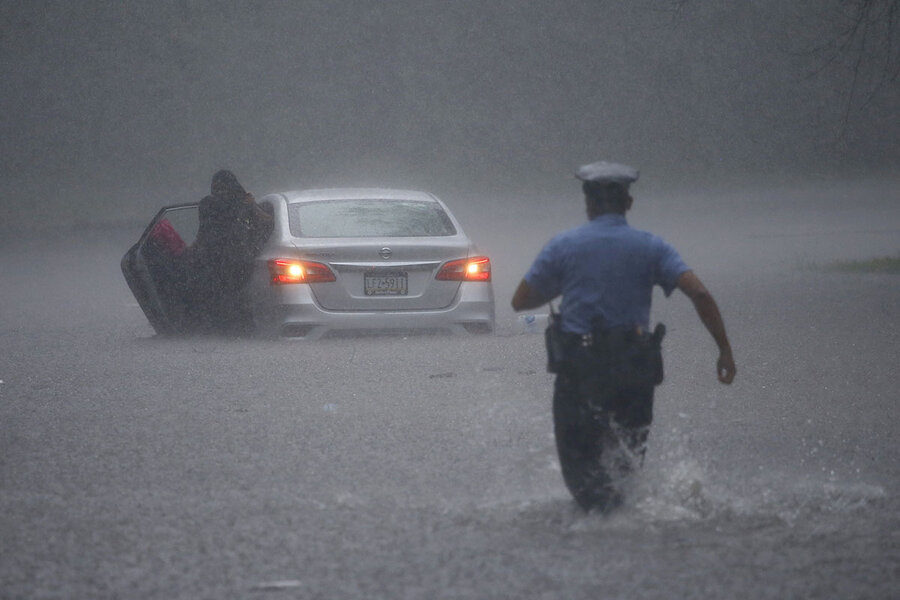Original publication by Stephanie Hanes for csmonitor.com on 15 March 2023

Michael Probst/AP/File
The world’s emissions of heat-trapping carbon dioxide rose to record levels last year, according to a new report from the International Energy Agency, but renewable energy sources continued their exponential growth – and some analysts believe that the world’s fossil fuel demand has peaked.
If that seems like contradictory news for the world’s climate, that’s because it is, says Kingsmill Bond, an energy strategist with RMI, an energy and climate research organization.
Welcome to the half-full and half-empty world of climate action in the 2020s. This decade is shaping up as a transition point toward increasing reliance on clean energy, even as fossil fuel use hasn’t yet started to decline. It is a moment when everyone from corporations to politicians to financial institutions is touting moves toward zero-carbon economies, even as governments across the world – including the Democratic U.S. administration – approve new fossil fuel development.
The report, the international agency’s latest annual effort to crunch energy-related greenhouse gas data from multiple countries, paints this complicated picture: There are key points of hope and optimism, but also the reality that the world continues to send heat-trapping gases into the atmosphere at unprecedented levels.
“The reason it’s terrible news is that we still have very high levels of emissions,” Mr. Bond says. “The reason, however, that it’s good news is that emissions have peaked and we’re basically on a plateau.”
This matters because for decades, climate research has pointed toward a clear conclusion: Sending more greenhouse gases into the air means the world’s temperature will increase. The global warming caused by human emissions is already starting a cascade of environmental and human challenges, scientists say, from extreme weather to sea-level rise to crop failures. And they predict it will get worse for each fraction of a degree that the Earth heats.

Jacob Turcotte/Staff
“We really do need to get [emissions] down because we have a serious carbon budget that we need to adhere to if we want to avoid the worst impacts of climate change,” says Doug Vine, director of energy analysis at the Center for Climate and Energy Solutions.
International Energy Agency analysts found that global energy-related carbon dioxide emissions – the largest source of human-caused greenhouse gases in the atmosphere – rose by under 1% in 2022. This is far less than many researchers had predicted, especially given the global energy crisis and conflict in Ukraine, which many had thought would create a spike in emissions.
In Europe, for instance, the agency’s analysts found that rather than increasing, emissions dropped 2.5%. That’s despite Germany resurrecting or extending the life of at least 20 coal-fired power plants, and despite the temporary offlining of a number of nuclear power plants, which provide low-emission energy.
Strong energy conservation efforts in Europe, such as turning down the thermostat and switching over to heat pumps, helped cause this drop, aided by a mild winter. The region’s increasingly rapid turn toward renewable energy sources also helped prevent a spike in greenhouse gas emissions.
“Renewables is what has saved us from Russian energy blackmail,” says Mr. Bond, who is based in Britain.

Pavel Golovkin/AP
Indeed, energy analysts say that without the rapid, global rise of renewable energy sources, such as wind and solar power, the emissions picture would be far worse.
“The impacts of the energy crisis didn’t result in the major increase in global emissions that was initially feared – and this is thanks to the outstanding growth of renewables, EVs, heat pumps and energy efficient technologies. Without clean energy, the growth in CO2 emissions would have been nearly three times as high,” Fatih Birol, executive director of the International Energy Agency, said in a press release.
But coal, known as the highest-emission energy source, is still on the rise – particularly in developing countries. Emissions from Asia’s emerging market and developing economies (excluding China) rose far more than those in other regions, according to the report – some 4.2%. Over half of these came from coal-fired power generation.
And it’s not as if other fossil fuel sources are going away yet.
In the United States, for instance, emissions increased slightly, by 0.8%, but the country also increased its use of natural gas by some 89 megatons. (Although sometimes praised as “cleaner” than coal, natural gas is still a fossil fuel that releases carbon dioxide into the atmosphere. It also is connected to the release of methane, a greenhouse gas that is shorter-lived but traps more heat than carbon dioxide.) A good percentage of this natural gas was used for air conditioning, thanks in part to unusual heat waves across the country – a sign, analysts say, of the way that the causes and effects of climate change can spiral.
Around the world, oil emissions also increased last year, in large part because of a rebound in the aviation industry, the report found.
“I was particularly surprised by the stubbornness of energy-related emissions, which continued to rise despite some very strong headwinds, including an apparent decline in overall emissions from China (another major surprise), the ongoing energy crisis in Europe, and record additions of alternative energy sources,” Akos Losz, senior research scholar at the Center on Global Energy Policy at Columbia University, wrote in an email.
For researchers like Rachel Cleetus, policy director with the climate and energy program at the Union of Concerned Scientists, the continued fossil fuel emissions are proof of the need for more sweeping, systemic change.
“We need to be cutting emissions by 6% to 7% a year now,” she says. “This trend of continued growth is just very, very sobering. It’s off track from where we need to be.”

Matt Slocum/AP/File
For years, she says, she and others involved in climate research have looked toward renewables as an answer to the crisis of global warming. Finally, this technology not only exists, but is also proving economically competitive with fossil fuels. Policies such as the U.S. Inflation Reduction Act are poised to give renewables even more of a boost – something financial analysts like Mr. Bond see as indication that renewables will soon become the world’s dominant energy sources.
But this report, Ms. Cleetus says, shows that technological change is not enough to fix the climate crisis. It’s also about mindsets, influence, and societal priorities.
“On the technology side there’s only good news here. … The technology is more than performing. For those of us who have been doing this work for a couple of decades, it’s beyond our wildest dreams. And that’s when it pulls you up short to realize, ‘Wow. We can have the technologies. They’re fully deployable. So what’s standing in the way?’ But this has never been just a problem about technology. It has always been about power and politics and money.”




